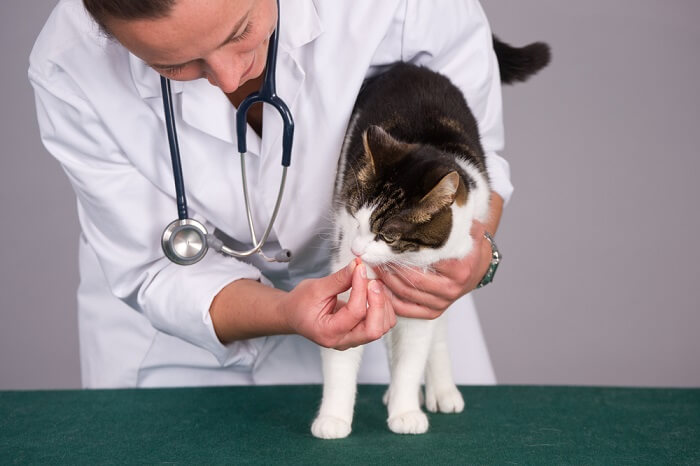
Our pets can be hosts to a number of intestinal parasites, including roundworms, hookworms, tapeworms, and whipworms. These parasites can affect the overall health and wellbeing of our companion animals. Whipworm infections can be especially challenging. They are harder to diagnose and treat and their eggs are much more hearty than other intestinal parasites.
Types of Whipworms
There are two species of whipworms that can infect cats: Trichuris serrata is found in North America and Trichuris campanula is found in Europe. Whipworms are species-specific and Trichuris vulpis, does not survive in cats.
Causes and Transmission Mechanisms
You will not see adult whipworms in the feces of an infected cat. To make this diagnosis, the microscopic whipworm eggs are identified in a specially treated stool sample from the infected cat, usually through fecal floatation. This is why your veterinarian recommends you bring in a stool sample with your cat’s annual check-up.
Adult worms live in the cecum – a C-shaped portion of the large intestine where the small intestine meets the large intestine. In heavy infections, they can also live in the ilium, which is the final portion of the small intestine and the colon where they release larvae.
The head burrows into the mucosal tissue of the intestine and absorbs blood and nutrients. The tail of the worm is free in the lumen of the intestine releasing eggs that are passed through the stool. The tail “whips” back and forth as ingesta move through the large intestine, giving the parasite the common name “whipworm”.
How Do Cats Get Whipworms?
Eggs passed through the feces and are deposited in the environment. Once outside the body, an embryo will form within the egg. The egg becomes infectious after an embryo has formed within it, a process that usually takes two to four weeks.
A cat ingests an embryonated egg and becomes a host to the whipworm. The embryonated egg hatches in the small intestine of the cat where it lives for about a week before moving on to the large intestine and cecum. The whipworm will feed for about three months before it starts producing eggs.
Symptoms of Whipworm

The signs of whipworm infection vary depending on the number of worms the cat hosts so if there are only a few worms, many cats won’t have any signs.
Clinical signs of whipworm infestation vary depending on the number of worms the cat hosts. If there are only a few worms, many cats won’t have any signs. Cats with a larger number of worms can develop bloody diarrhea with straining and frequent, urgent bowel movements.
Common clinical signs include:
-
- Diarrhea (often containing blood or mucus)
- Weight loss
- Lethargy
- Anemia (pale gums)
- Dehydration
- Poor coat condition
- Scooting or dragging their bottom on the ground
The diarrhea is often watery and may contain fresh blood and mucus. If the worm burden is heavy enough, the kitty may lose large amounts of protein through the intestinal tract, causing weight loss, lethargy, anemia and a potbellied appearance due to fluid build-up in the abdomen.
Heavy numbers of whipworm can cause intestinal obstruction or cecocolic intussusception, a telescoping of the intestine into the cecum, both of which are life-threatening conditions.
How To Treat a Whipworm Infection

Whipworm infections can be challenging to diagnose since they do not produce large of a volume of eggs and also it can take up to three months before they release eggs in the stool.
Whipworm infections can be challenging to eliminate for a couple of reasons. The infectious eggs can survive in the soil for up to five years. Unlike other parasites, their eggs are not killed by freezing temperatures or dry conditions. This can lead to recurrent re-infections from the pet’s environment, such as a litter box.
In addition to the heartiness of the egg, whipworm infections can be challenging to diagnose. Parasites are usually identified by finding the eggs in a feces sample. Whipworms do not produce as large of a volume of eggs as other parasites. Also it can take up to three months before they release eggs in the stool. Both of these factors make it more challenging to diagnose a whipworm infection.
Treatment for feline whipworms involves deworming with either fenbendazole or febantel daily for three consecutive days. Because of the lifecycle of the whipworm, treatment should be repeated three weeks after the initial treatment and again three months later.
Frequently Asked Questions
How does a cat get whipworms?
Transmission of whipworms is fecal to oral spread. The egg is passed in the feces of an infected cat. The egg is ingested by another cat where it hatches and moves into the large intestine. Cats may re-infect themselves by contaminating their environment with whipworm eggs. The eggs can live in the soil for up to five years.
What kills whipworms in cats?
Fenbendazole and Febantel are dewormers that kill whipworms. They need to be given daily for three consecutive days. It is also recommended to repeat deworm again three weeks later and again in three months because of the lifecycle of whipworms. Milbamycin is another alternative medication that can be given monthly in areas where the environment is contaminated.
What does whipworm infection look like in cats?
Some cats may have whipworm and not show any signs, especially if they only have a few worms in their GI tract. Other cats can have watery diarrhea, flatulence, and blood or mucus in the feces. Some cats may have significant weight loss or fluid buildup in the abdomen.
How did my indoor cat get whipworms?
Your cat ingested an infectious whipworm egg at some point. This may have been before he came to live with you or could have become infected from another cat in the household. Studies have also shown that potting soil can contain parasitic eggs. This is why it is very important to have a fecal parasite test performed on your cat at least yearly.








What would the dose of ivermectin be per pound for a cat, to kill any whipworms?
Thanks–
DS
It’s difficult to find good dosing information for using ivermectin for cats with whipworms—most sources recommend doing so only under the supervision of a vet to avoid overdosing. Therefore, I can’t confidently give you a recommendation. Alternatively, you can try Drontal tablets, which are effective against whipworms and available at a low price.